 |
| john king photo A female university volleyball player reaches toward the ball to spike it into the opposing side. |
While I didn't know that at the time, I was already approaching the assignment with trepidation. Something nags me when I do work for free, even when it's for school. It's hard for journalists to do work without getting paid, but I reconciled this with the fact that I will receive marks for the assignment, which in itself, is a form of payment I suppose.
So going into the event somewhat demoralized created a more difficult situation than need be. I find photography is 99 per cent a mental game. The photographer who's not mentally prepared will not get the shot they want because they're not focused.
It was one of the final games of the season for the women's Thompson Rivers University Wolfpack volleyball team. They were pitted against a ferocious Manitoba Bisons team. Because the environment was small and intimate, I decided to not bother announcing myself to everyone as some kind of photographer by immediately placing myself ringside; instead, I sat in the bleachers for most of the time trying to snap a few good ones without staying there all evening long. I realized I was going to have problems right away because of the lighting. I prefer to use my old Canon (a model most professionals would say is only something an amateur would use), so it took some time to find the right adjustments where I could capture the movement of the players without too much blurring, which is difficult in a large low-light setting such as a university gym, but still better than the lighting in most high school gyms.
I realized after taking photos for awhile that people were noticing me. There was another photographer present, therefore most people realized that one of us was probably with the local newspaper in town, and that it was probably the guy with the big, fancy long lens walking around the edges of the volleyball court who was getting paid to be there.
I ignored the glances, as I did speak with the university's sports contact to ensure the school knew I would be there to take photos -- not that it matters much because it's perfectly lawful for anyone to show up and take photos of the sports event, a public event in a public setting. But there are always external issues to consider when taking photos in a public setting, and being transparent and honest about your intentions is usually the best course of action.
When I finally arrived home and started sorting through my photographs, I realized I had not completed the objective of the assignment properly, as I took photographs of a varsity sport when the professor had asked us not to do so. While frustrated at first, I soon realized going to the event was good practice. Journalists get rusty if they aren't doing journalism every day. It felt good to go out and take photographs of people doing things; it's the sort of exercise that helps a photographer remember why they take pictures in the first place.
What is photo gazetteer?
The story behind the photograph is just as important as the photograph itself. This is a blog that will look at the stories behind the photographs shaping our world, everything from the small and mundane, to the big and spectacular. Feel free to comment on photos and share your own.
This blog is managed by designer and journalism student John King

No comments:
Post a Comment